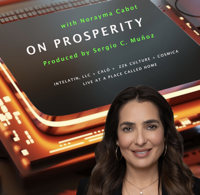
Author’s Note:
At A Place Called Home, a nonprofit organization that offers support to South Los Angeles youth and families to achieve social, emotional and economic success, I asked Norayma Cabot if she could rank the economic well-being spectrum of the children in South Central on a scale from one to 10, with one being really bad and 10 being really good.
Cabot said she believed it to be a three. But she believed that all the children had everything they needed inside to make it to 10 as long as the social policies in the U.S.A. allowed.
In this election year, I wonder what it is that the most vulnerable BIPOC children can do to begin to climb that spectrum.
With the President-elect having a 1.5% majority mandate and a pro-business agenda, a favorable tax policy for the billionaire class and extreme deregulation, I do not see how vulnerable children factor into the nation’s priorities.
I wish I was as positive as Cabot. I loved walking the halls of A Place Called Home with her. She seems so at peace and I know that her peace vibes with the children.
At A Place Called Home, a nonprofit organization that offers support to South Los Angeles youth and families to achieve social, emotional and economic success, CALÓ News asked Norayma Cabot if she could rank the economic well-being spectrum of the children in South Central on a scale from one to 10, with one being really bad and 10 being really good.
How do you identify?
I was born in Los Angeles, and as a child, I spent every summer in my parents' hometown in Nayarit. There, people called me "Guerita.” My identity in Mexico was as La Guerita del Norte, which felt quite different from how I saw myself in East L.A. I remember asking my mom why they called me that because, in the United States, I was very much identified as Mexican. Today, my identity shifts depending on the audience, the day and the role I’m in. As a CEO, I identify as Latina, while in my personal life, I connect more closely with being Mexicana. My Mexican traditions are woven into my daily life, and I embrace them as part of who I am, especially as a single parent striving to keep them alive [for] my children.
Please describe your childhood home
My childhood home was in Maywood where my parents still live today. We moved there from East L.A, where we had been renting and living with family and relatives. I vividly remember the first time we drove up to the house, I saw so many beautiful trees, the front yard, the walkway and the driveway. It all seemed so huge to me, especially since my room was way in the back. I thought the home was beautiful and I was so excited to live there. It was such a contrast from the apartment in East L.A. The house was a peachy color, which I now realize wasn’t exactly the most attractive, but at the time, I didn’t see it that way. It was a single-story home, with four bedrooms and two bathrooms. It had two living rooms, which felt so fancy to me. We had family in Huntington Park and my father worked in the City of Commerce, so Maywood was a familiar area and felt like the right place for us.
Where did you see your family on the economic spectrum?
I never thought we were rich, but I felt we were doing fine. I am one of three kids and my mom stayed home to take care of us. We spent our summers in Mexico visiting my grandparents, which was a treasured part of my childhood. Once a year we’d head to downtown L.A. to shop for back-to-school clothes, filling up a large black trash bag. I thought it was a great experience and I didn’t know any different. It wasn’t until high school that I even heard of a Mall. I didn’t know that world existed. Our life wasn’t fancy but I never felt I was lacking anything. My parents did a great job of providing everything we needed.
What does your home look like in the present day?
I love my home. It’s a significant personal accomplishment for me. Every time I walk to my front door, I feel proud of what I’ve been able to achieve. I live in a cul-de-sac, with no neighbors in the front or in the back, which gives us a sense of privacy. My kids enjoy shooting hoops in the front where we have a basketball net. It’s a single-story home with beautiful landscaping. A three-car garage. I have a pool. A nice pergola with a firepit. One of my favorite things is organizing movie nights in the backyard during the summer.
Is this your first home that you purchased?
This is the first home that I bought entirely on my own. I had previously purchased a home with my ex-husband but I wasn’t the primary purchaser because I didn’t have the capital or the credit to be on the loan.
I’d love to talk about your transition from being a renter, to a co-applicant on a mortgage to being a primary homeowner. How did that feel for you?
We were victims of the 2008 crisis and lost our home. It was absolutely devastating. In the Latino culture, homeownership signifies a level of success and achievement, so losing that home made me feel like a failure. I was embarrassed that we couldn't hold on to our home. I felt that I failed my family. I made a vow to get us back on our feet and I knew I had to be the one to drive that change. I took control of our finances, put us in a position to secure a home and made sure we could keep it. There was a moment when I knew I had to do it on my own. As a teen mom from East L.A. and Maywood, being able to buy a house in a nice area, like Hacienda Heights .... that was an incredible feeling. One of my proudest achievements.
How old were you when you became the driver in your financial life?
I was in my early 30s when I took the reins of my financial life. But, let me tell you, back when I was an undergrad at Cal State L.A., I had an assignment called the Tour of L.A. We had to study the community, everything from street signs to how wide the streets were, parks, businesses. Part of the assignment involved looking at the census tract, and that’s when I learned that Maywood was classified as a low-income area. I remember going home and asking my mom if we were poor! She was shocked to see how naive I was and started pointing out all the ways we were, in fact, low-income. It was something I never realized as a child.
Is it probably because you were well-loved?
Absolutely! I never felt like I was missing anything. We lived modestly but I had the love of my family and that made all the difference. Looking back, I now realize that I didn’t have a lot of access and opportunities. My children don’t live the same way that I did and that’s something I’ve been very intentional about.
Who is doing better economically, the ten-year-old in Maywood or you in the present-day in Hacienda Heights?
Definitely me, now. I’ve achieved the financial stability I once aspired to, but my vision today is much more robust and holistic. It’s no longer just about my comfort, it’s about the impact I can have on those around me and my community. As a CEO, I often share that I didn’t aspire to this role when I was younger because back then, there were no women, no Latinas in these positions. It didn't seem possible. It was a long, tough road to get to where I am now. I was raised in a Latino household, was the first in my family to go to college, and became a teen mom at 18. I feel deeply connected to my community, and it fills me with pride when the children in my community come to me and say, “I’m so happy you are here, and you are a girl, and you look like us!” That makes me incredibly proud.
At A Place Called Home, with a target geography of South Central LA, 90%+ Latina/o, eight to 24-year-old demographic, if you had to put them on the economic well-being spectrum with one being really bad and 10 being really good, where would you place the children?
I would place South Central L.A. at a three. Despite the significant strides we’ve made and the enormous efforts by amazing organizations, there is still so much generational and systemic neglect in South Central L.A. The area remains impoverished, with a severe lack of resources and opportunities. We’ve come a long way, but there’s still so much work to be done to provide more access and opportunity for our youth.
There was the Gloria Molina and the María Elena Durazo era in LA but we need the female leadership in South Central L.A. to help us improve that number, right?
Absolutely, the era of Gloria Molina and Maria Elena Durazo was transformative for L.A., and now we need to build on that legacy with strong female leadership. To improve the economic well-being of our community, especially for our youth. We need leaders who understand the unique challenges here and are committed to making systemic changes. At A Place Called Home, our entire C-Suite is composed of women of color, and we’re dedicated to leading differently, setting new examples for those who come after us. It’s about more than just filling leadership roles; it’s about transforming the community through intentional and inclusive leadership.











(0) comments
Welcome to the discussion.
Log In
Keep it Clean. Please avoid obscene, vulgar, lewd, racist or sexually-oriented language.
PLEASE TURN OFF YOUR CAPS LOCK.
Don't Threaten. Threats of harming another person will not be tolerated.
Be Truthful. Don't knowingly lie about anyone or anything.
Be Nice. No racism, sexism or any sort of -ism that is degrading to another person.
Be Proactive. Use the 'Report' link on each comment to let us know of abusive posts.
Share with Us. We'd love to hear eyewitness accounts, the history behind an article.